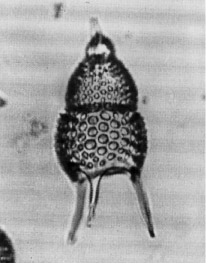 Thyrsocyrtis
(Pentalacorys) tensa Foreman
Thyrsocyrtis
(Pentalacorys) tensa Foreman Thyrsocyrtis
(Pentalacorys) tensa Foreman
Thyrsocyrtis
(Pentalacorys) tensa ForemanThyrsocyrtis hirsuta tensa Foreman, 1973, p.442, pl.3, figs.13-16, pl.12, fig.8; Sanfilippo and Riedel, 1982, p.176, pl.1, figs.6-7, pl.3, figs.1-2 (with synonymy)
Similar in general form to T. hirsuta, except that the pores of the abdomen are markedly larger than those of the thorax (at least 1.5 times as large, with 5-6 pore centers in 50 µm on thorax and 3-4 in 50 µm on abdomen), and the abdomen is inflated. Feet are slightly curved with convexity inward, or straight, and usually do not show the medial thickening that is characteristic of those of T. hirsuta. Rare specimens have feet porous in the manner of T. tarsipes, or bladed in the manner of T. lochites. In both of these, the abdomen tends to be more inflated than usual (Sanfilippo and Riedel, 1982).
Based on 15 specimens. Length excluding horn 190-265 µm, of cephalothorax 70-105 µm, of abdomen 55-80 µm. Maximum breadth 100-135 µm (85-140 µm according to Foreman, 1973) (Sanfilippo and Riedel, 1982).
T. tensa differs from T. hirsuta in larger abdominal pores, and from its descendant T. triacantha in having feet descending straight down or with convexity inward (Sanfilippo et al., 1985).
T. tensa varies greatly, some forms being robust and others more delicate with thin shells and spindly legs. Rare specimens have feet porous in the manner of T. tarsipes, or bladed in the manner of T. lochites. The abdominal pores are markedly larger than those of the thorax (5-6 pore centers in 50 µm on the thorax, and 3-4 in 50 µm on the abdomen), increasing slightly in size as the abdomen becomes more inflated in later forms. Feet are slightly curved with convexity inward; towards the end of its range becoming straight and without the medial thickening characteristic of T. hirsuta (Sanfilippo et al., 1985).
T. tensa is found in all tropical oceans in middle early to early middle Eocene assemblages. Its evolutionary transition to Thyrsocyrtis triacantha is approximately synchronous with the lower limit of the Thyrsocyrtis triacantha Zone. Its morphotypic first appearance lies within the Buryella clinata Zone.
T. tensa is part of the Pentalacorys evolutionary lineage leading from T. hirsuta via T. triacantha to T. tetracantha.